|
The last I had seen
of my friend Carlo was out at Grant Narrows, where he showed me
an odd-sounding flycatcher that he was really hoping was an Alder
Flycatcher. Well, shortly thereafter, Carlo was walking around
near Surrey Lake Park when he heard the real deal: an unmistakable
Alder. I was pretty astonished at his luck, and even more so when
he found yet another nonlocal flycatcher, an Eastern Pheobe, near
the entrance of Surrey Lake.
Since I'd never been
to this park before, I figured a trip was in order. So on Friday
the 16th, I left work a little early and drove the short distance
to the park.
As I entered, I looked
briefly for the Pheobe, and not finding him, I proceeded on in.
As I came off a small bridge that crosses a creek, a heron took
off from the edge of the lake to my right. It was small, and most
probably a Green Heron, as they had also been reported at this
location. I was a bit disappointed, because I've only seen a Green
Heron once before, and I was hoping to get pictures of another
one.
The disappointment
didn't last long, though, as I started exploring this unfamiliar
land. I reached a branch in the trail, and took the south fork.
This led me through some open ground, with lake and meadow on
my right and forest, a ways off, on my left. I heard a cry and
looked up to see an adult Bald Eagle. It called a few more times
as it flew by.
|
|
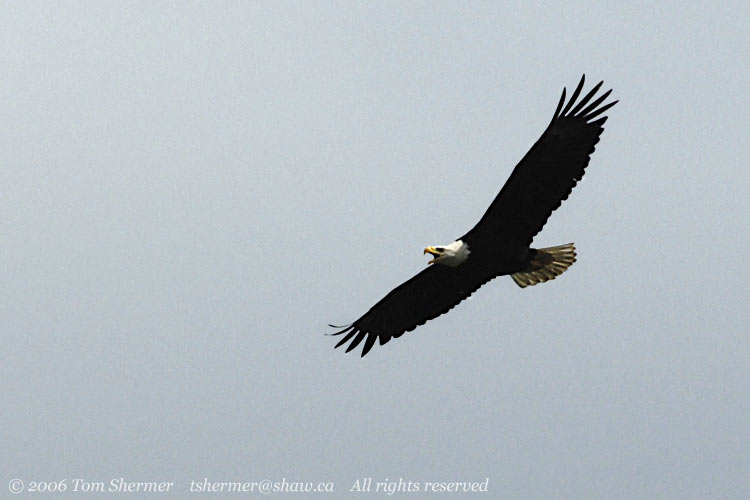 |
| As I watched,
the eagle turned about 180 degrees and lowered his landing gear. |
|
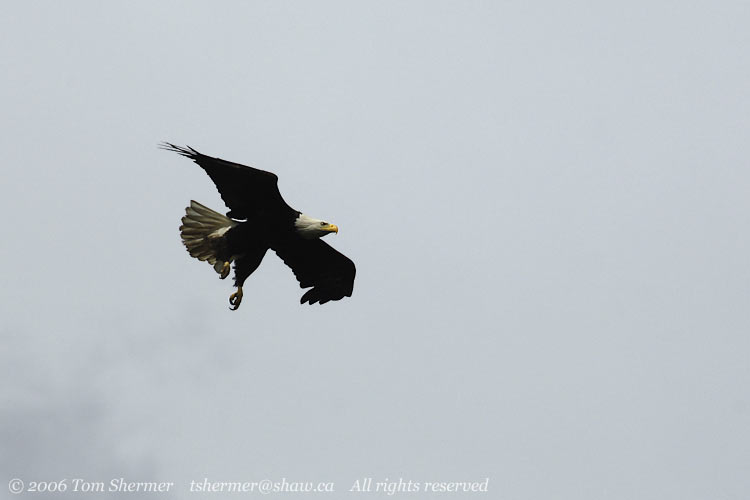 |
| It looked
like he was coming in for a landing on a snag. |
|
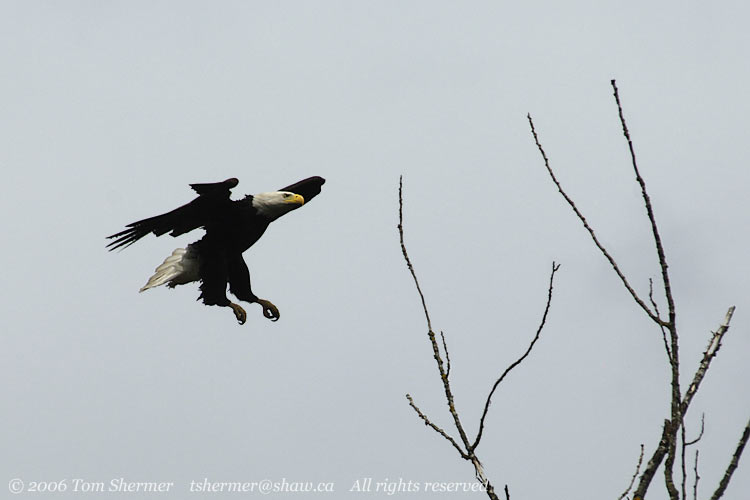 |
| But no,
he sailed right on by, keeping his body tilted but head level, like
a landing Concorde. |
|
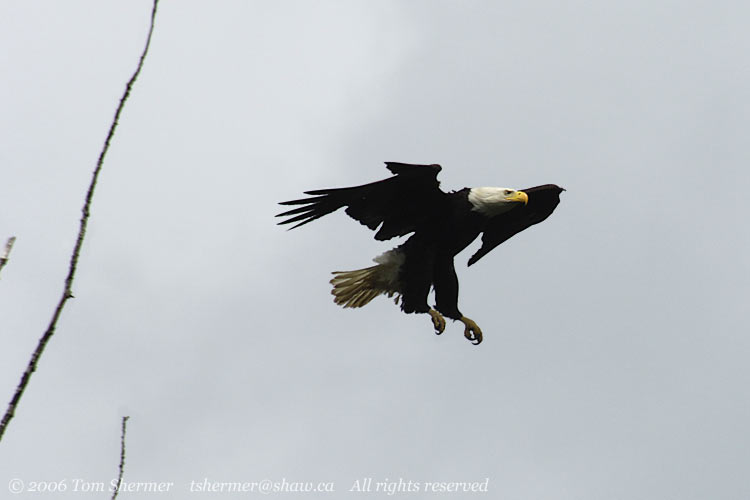 |
| Soon he
approached another tree. |
|
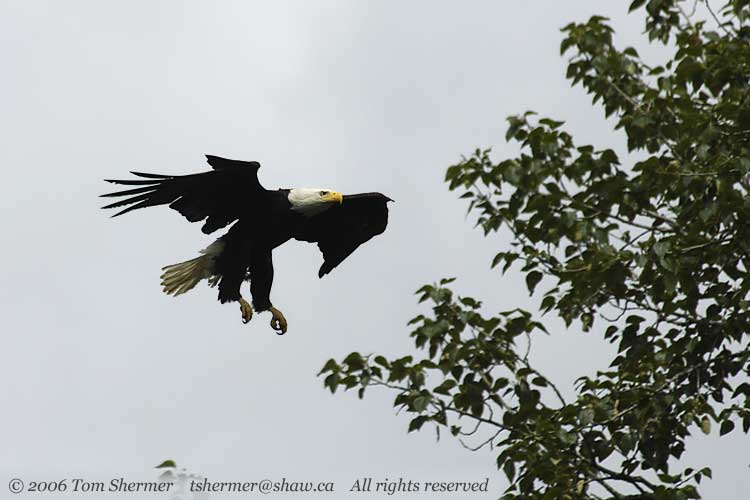 |
| I lost sight
of him as he headed into it, but I kept my camera moving at the
right speed and still got photos. |
|
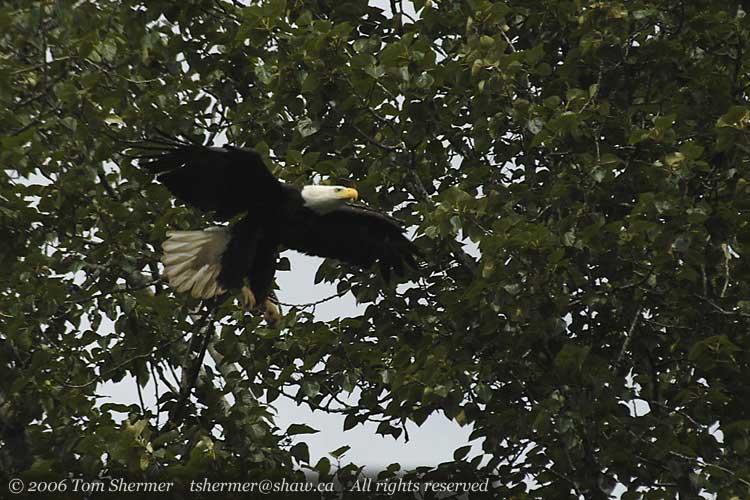 |
| But even
that tree was not to be his perch. |
|
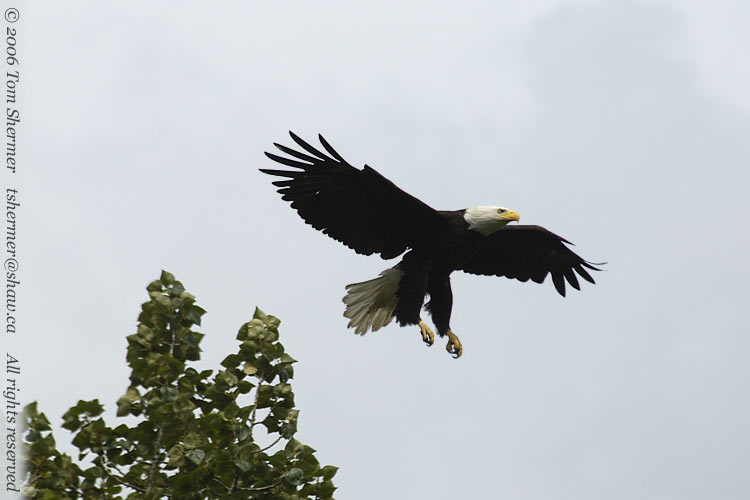 |
| Finally,
he really spread his wings |
|
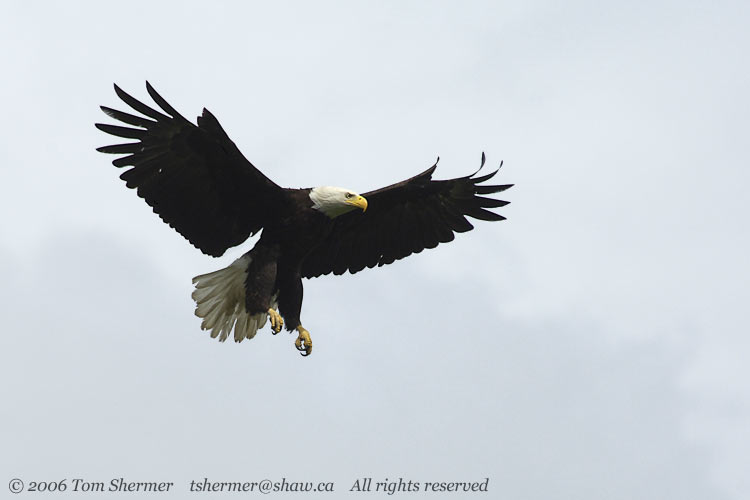 |
| and came
in to a landing on top of another snag. |
|
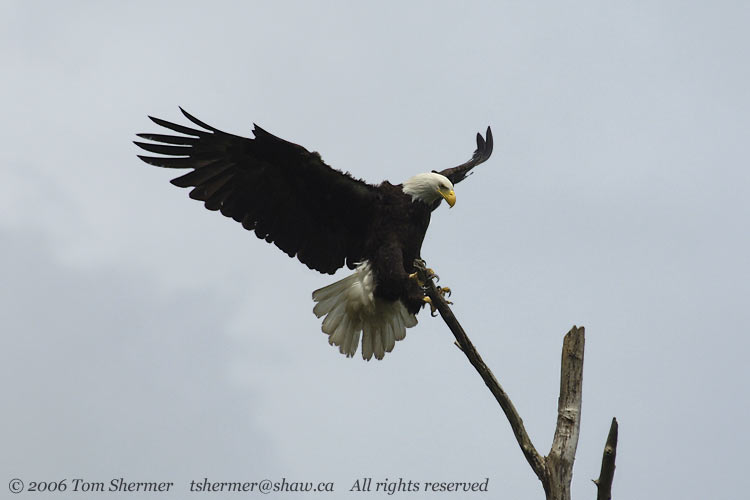 |
| |
|
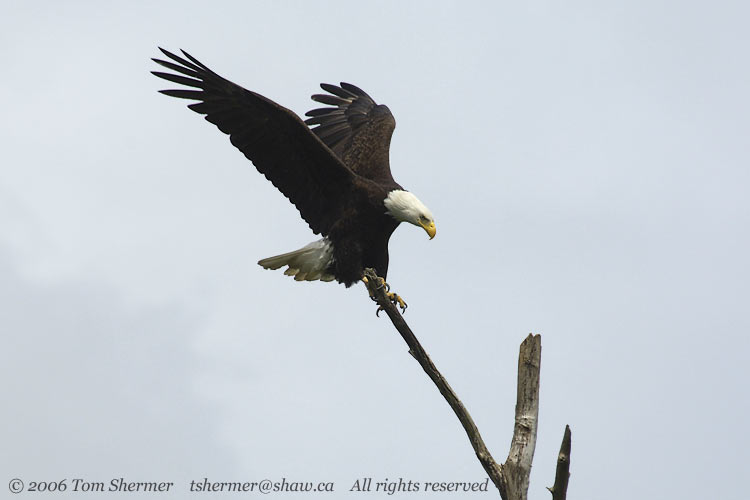 |
| |
|
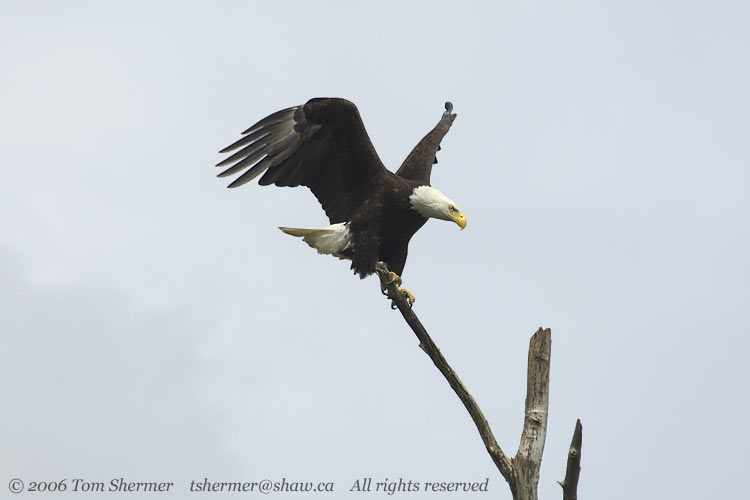 |
| Then he
looked around a bit, |
|
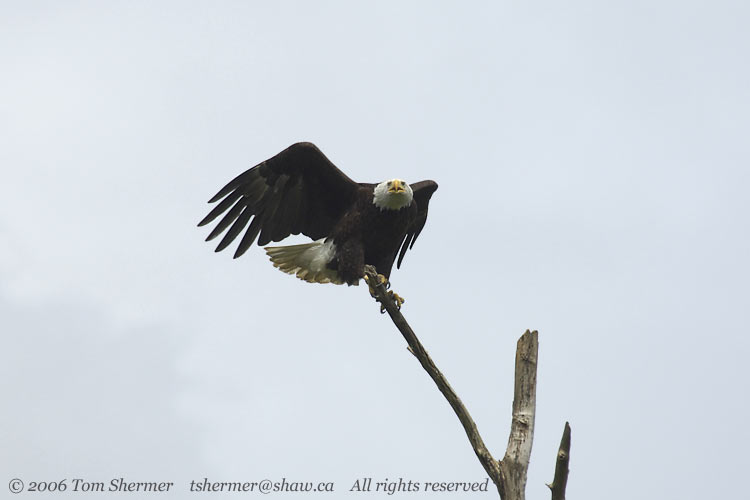 |
| made some
sort of gesture that I don't know the meaning of, |
|
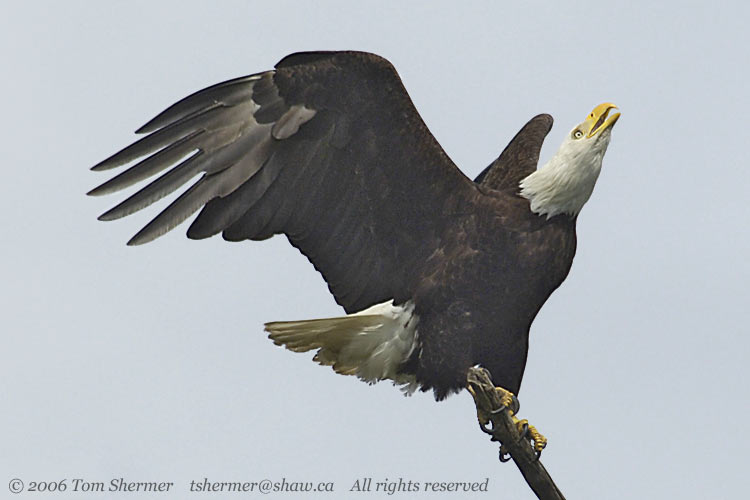 |
| and called
out to let the neighborhood know he had arrived. |
|
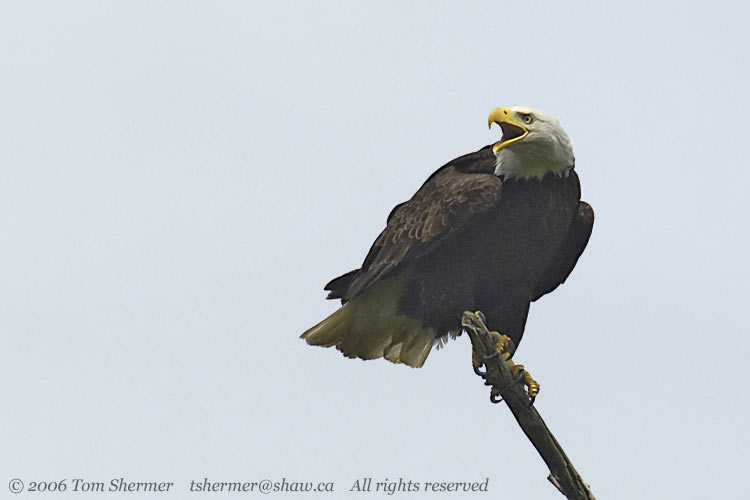 |
| I took a
few more shots of him perched up there. Here he's watching a crow
fly past. |
|
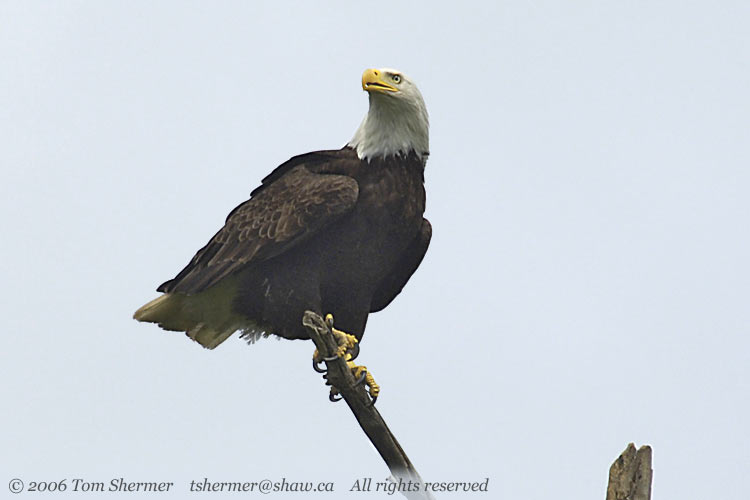 |
| And here
he's just bein' an eagle. |
|
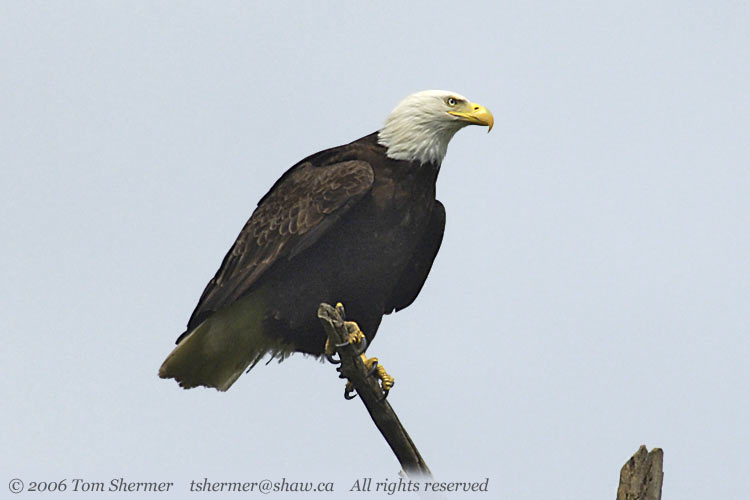 |
| I wanted
a shot showing the eagle and as much of the snag as I could get,
so I walked over closer to him and zoomed my lens as far out as
I could. I still wasn't able to get the bottom of the snag, but
at least this gives you an impression of the height of the thing. |
|
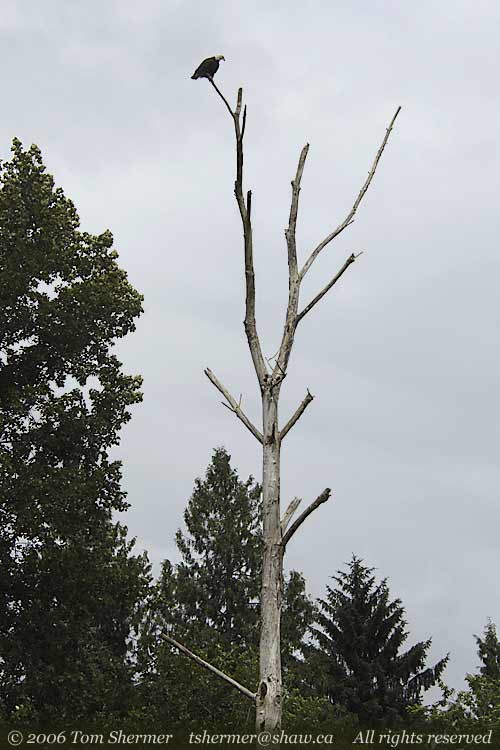 |
|
That had just been
a great few moments of birdwatching; I was amazed at just how
long he had his flaps down and body up; most birds don't drop
their legs or start to brake until they're almost right on top
of their perch. I was pretty exhilarated by the whole encounter.
I knew I had a pretty good chance of having gotten good photos
of it, too.
A bit excited now,
I wandered on, but at one point I turned back because I thought
I had gone the wrong way at the fork in the trail. Exploring the
other fork, I discovered that it led around to where I had turned
back, which was about fifty meters shy of the place I had been
looking for. Oh well, maybe I needed the walk.
The place I had been
looking for was a little trail that led out of the park on a dyke
that extended south between farms in the area. I headed out and
soon spotted an empid (flycatcher in the genus Empidonax)
in a tree to my left. It was either a Willow or an Alder Flycatcher,
but the chances are vastly in favor of Willow. It was still a
fair distance to where Carlo had heard the Alder, and even from
there, the bird was supposed to be in trees some distance off
onto private property.
|
|
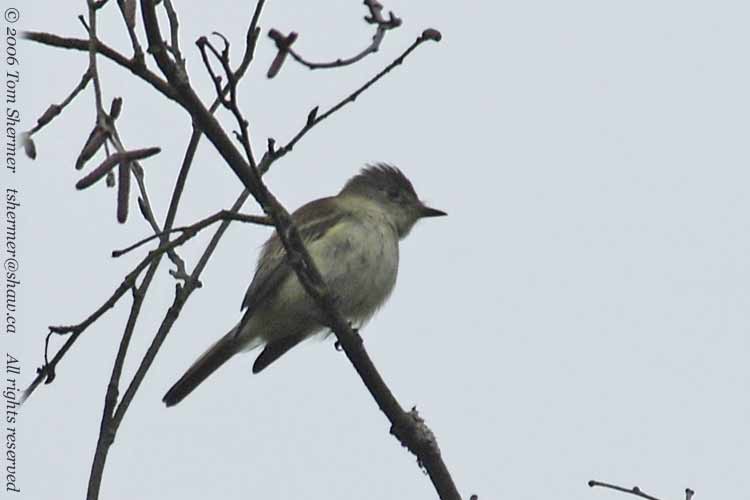 |
|
As I watched my empid,
he moved his mouth like he was calling, and I didn't hear a thing.
This really drove home the folly of my quest out here: how was
I going to find and identify a bird that is only identifiable
by sound when I can't hear them? But since I was most of the way
there, I pressed on, hoping for a miracle. Like finding a bunch
of experienced birders at the location listening to the bird as
it perched on a post five meters away. Yeah, I was hoping for
something like that.
In the meantime, I
passed a little meadow where a horse was enjoying some late afternoon
grass. She turned her head my way as I stopped to take her photo.
|
|
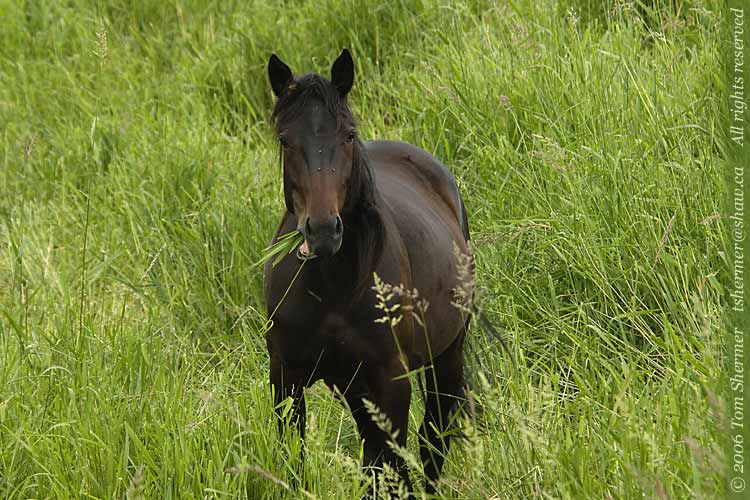 |
| When she
finished her grass, she moved a little closer to get a better look
at me. Those three flies on her nose didn't budge. |
|
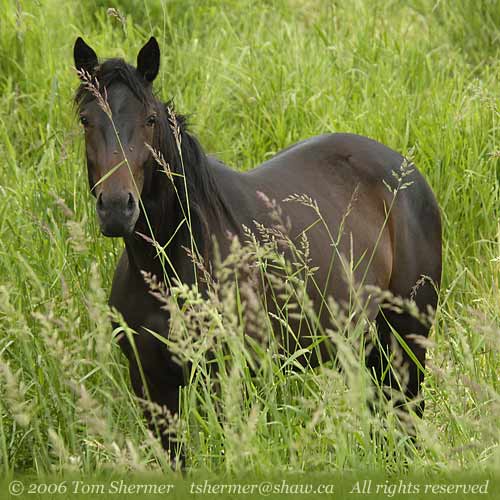 |
|
There's a species of
fly—Musca autumnalis, a close relative of the common
housefly—that is known for clustering on the faces of cattle
and horses, taking advantage of the fact that those poor animals
can't get a good grip on a flyswatter. Those flies were probably
M. autumnalis. I didn't get close enough to tell for sure,
though, and none of them came flyin' over to say hi. They liked
their horse nose too much.
I finally reached the
little weir where Carlo had heard his bird. My miracle didn't
materialize; there were no birders there. I went down to the bottom
of the structure and looked through my binoculars at the trees
where the bird was supposed to be. Those trees were far away and
to pick out a flycatcher at that distance I really needed my telescope.
And if the bird was making its distinctive call, I didn't hear
a thing.
So I settled for watching
what was nearby. A few Barn Swallows sat on the fence around the
makeshift dam.
Barn Swallows can be
really sneaky birds. Have a look at this guy, for instance. You
might think that he was just sitting there, mindin' his own business,
being a good little swallow.
|
|
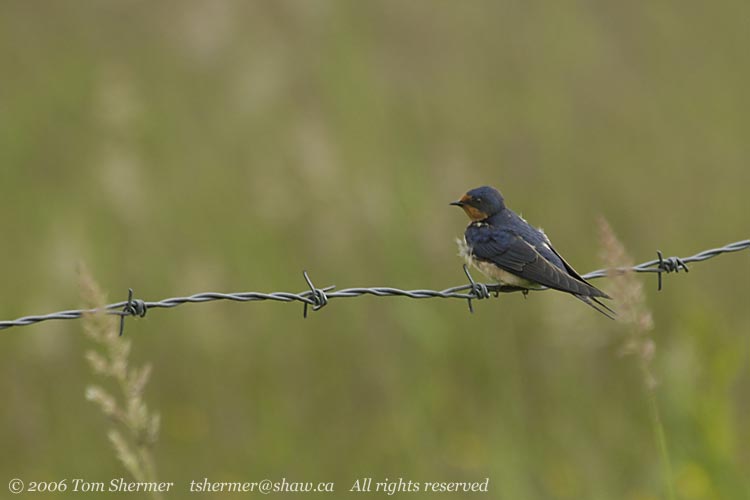 |
|
And if you did think
that, you'd be right. He was minding his own business.
But there was another
Barn in the area who wasn't. When the first swallow turned his
head, this guy snuck up on him from behind.
|
|
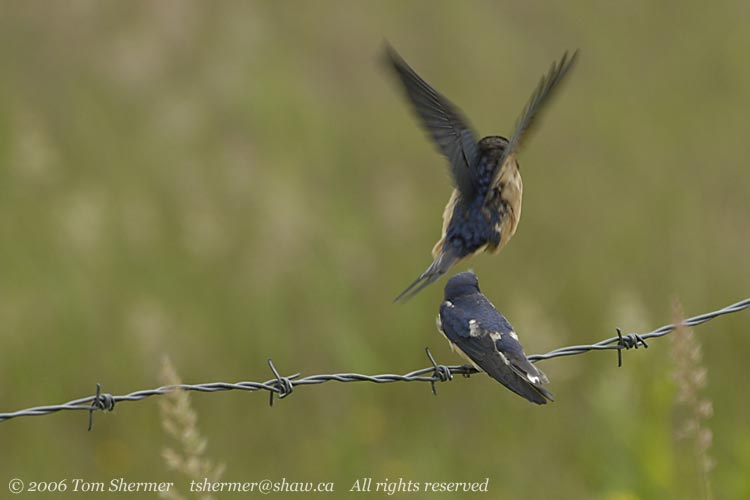 |
| And right
as the unsuspecting fellow turned his head, bam!...he got
a face full of swallow belly. |
|
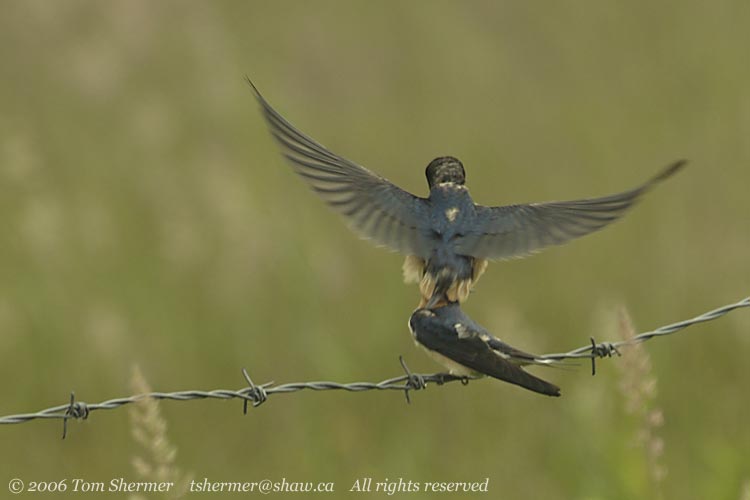 |
| The hooligan
then sped off, leaving his victim (and me) stunned and wondering
what the heck just happened. |
|
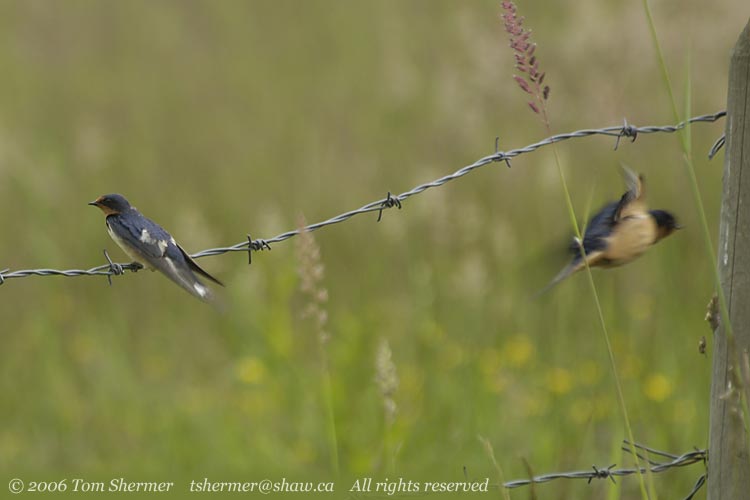 |
|
That was a very odd
exchange.
Eventually I got back
up onto the dyke, and I saw a long-tailed bird fly into some trees
far on the other side. My first impression was that it was a Mourning
Dove; they had been reported in the area. I don't see these doves
too often, so despite the distance I aimed my camera and shot.
The photos turned out pretty blurry, but at least they confirmed
my impression. So here's a bird-shaped smudge that looks a fair
bit like a Mourning Dove.
|
|
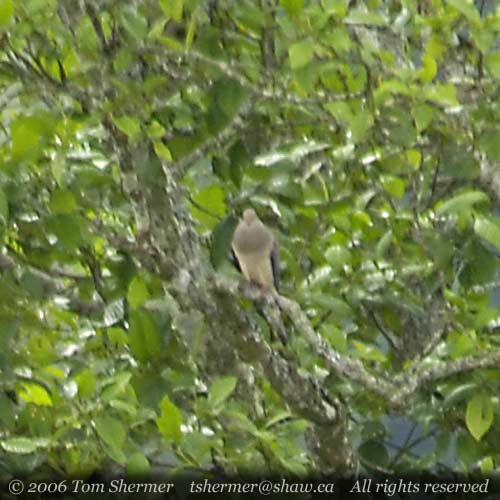 |
|
I headed back the way
I came, and took the path northwards when I got back to the park.
The northward way was through some woods, and since it was hot
out, I preferred the shaded walk, even though it would be a little
tougher for photography.
I'd seen a bunch of
black slugs on my walk, but I had to stop and take photos when
I encountered a really big brownish one. I put a penny there beside
him to give you a sense of how big he was. He didn't seem to mind.
|
|
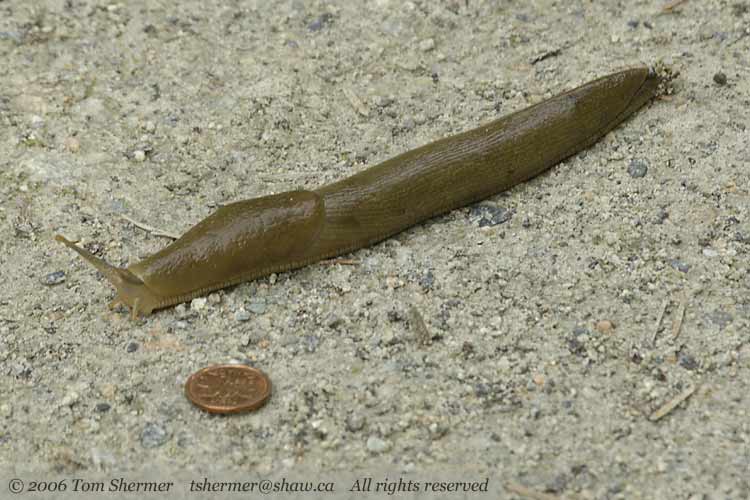 |
|
That slug was, as far
as I can tell, an Ariolimax columbianus, the Pacific Banana
Slug. (Lucky for you., I won't go into the anatomical details
that lead me to that conclusion...I'll save that for some other
day.) Unfortunately, at the time I was thinking photography rather
than science, and only took a photos of his left side. I'd be
able to tell for sure if I had a photo of his right.
The only other candidate
for a slug that big is my good friend Arion rufus, the
Chocolate Arion.
Speaking of which,
most of the slugs I saw out on the trail that day were definitely
the black form of A. rufus. I took some photos of one a
little later for comparison. This guy was about half as long as
the brownish one above.
|
|
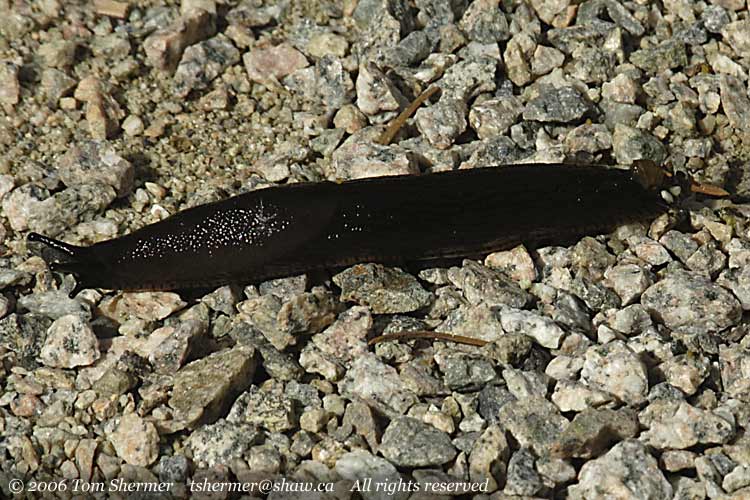 |
|
That's how they appear
when you look at them, but in Photoshop I was able to play with
the photo and bring up some of the surface details. In this version
you can really see the granular mantle (the lighter part of his
back), and the little ridging along the tail.
|
|
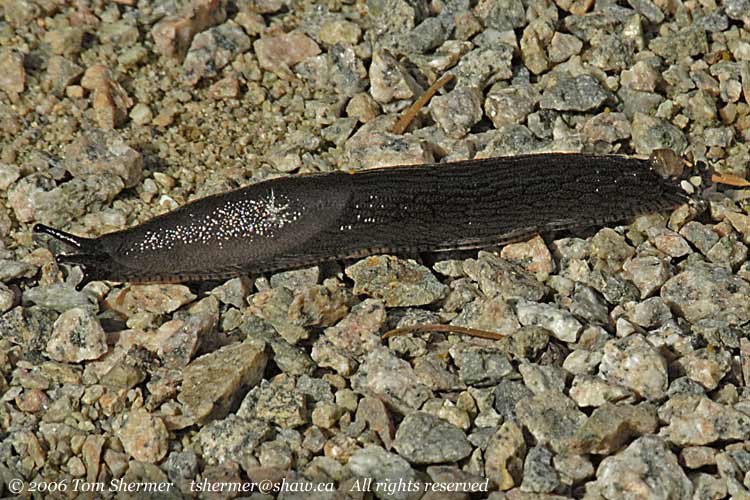 |
|
It's interesting how
shiny he was.
Soon I was back at
the lake, and I stopped to take photos when I saw a Belted Kingfisher
on a sluice gate on the far side. He was quite the distance away;
this is as close as I dared crop the photo.
|
|
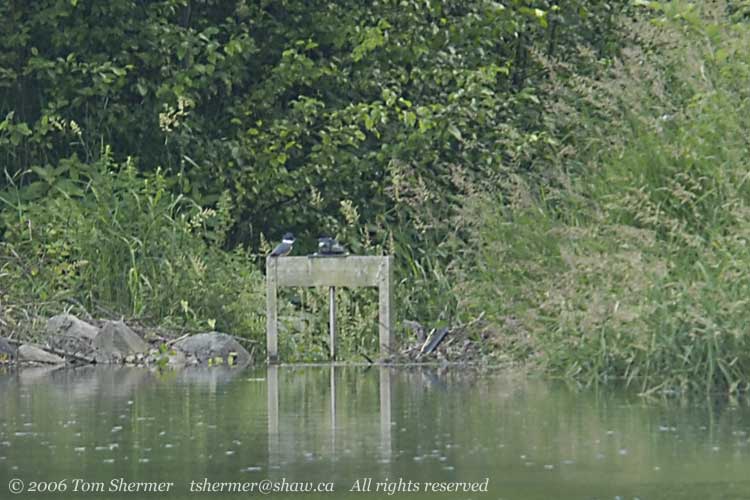 |
|
Back near the entrance,
I saw a momma Mallard with three young, near the place where the
heron had flown from earlier. The reflections made the water around
them a lovely green.
|
|
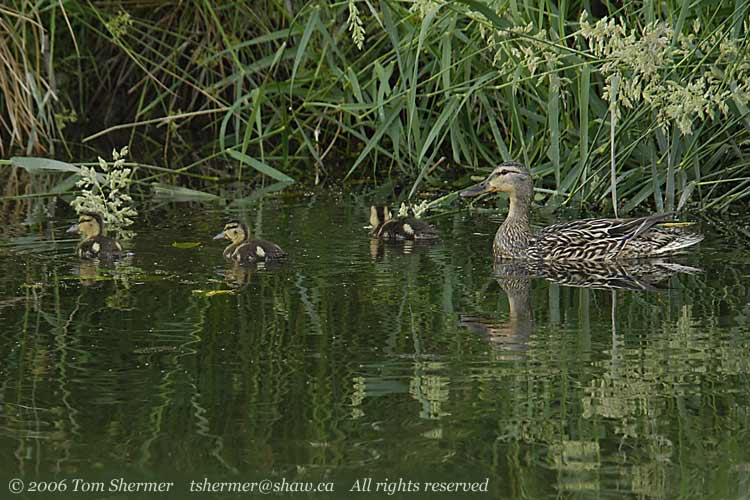 |
|
Back by the entrance,
I dropped my tripod in the car and tried one last time to spot
the Eastern Pheobe that was supposedly nearby. After fifteen minutes
or so, I saw a bird that was quite possibly the Pheobe fly behind
a large tree on the border of the park and a golf course. I waited
as close as I could to the fence for the bird to reappear. This
was not terribly close because the vegetation was overgrown there..
After another five
to ten minutes, I saw a dark bird appear on a low branch on a
tree, near the fence but behind a little vegetation. Despite the
obstruction, I took some photos, just in case that was my best
chance on the bird. It turns out this was the Eastern Pheobe.
|
|
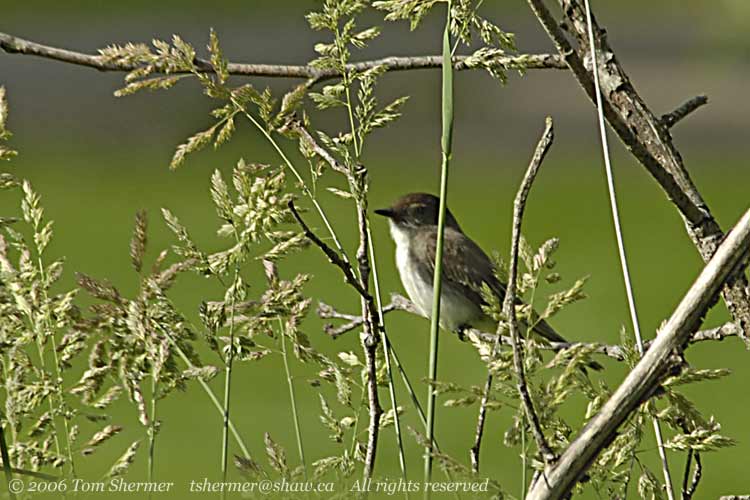 |
|
And it also turned
out that that was my best chance at photos of the bird. He flew
back behind the trees within a minute, and didn't come back out
in the next ten or so. Although it wasn't a great view of the
bird, it was okay, and I was able to tell he wasn't something
I'd ever seen before.
So I headed home with
the Eastern Pheobe, but not the Alder Flycatcher, on my life list,
and with some great encounters on my memory cards.
Walking on the moon,
Tom
|
|